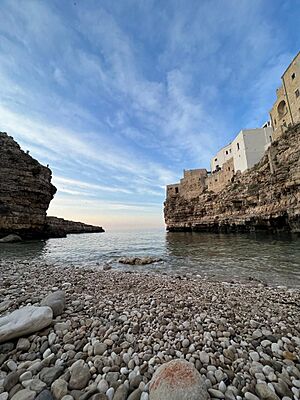Polignano a Mare facts for kids
Quick facts for kids
Polignano a Mare
|
||
|---|---|---|
| Comune di Polignano a Mare | ||

View of Polignano a Mare
|
||
|
||
| Country | Italy | |
| Region | Apulia | |
| Frazioni | Casello Cavuzzi, Chiesa Nuova, San Vito and a part of Triggianello | |
| Area | ||
| • Total | 67 km2 (26 sq mi) | |
| Elevation | 24 m (79 ft) | |
| Population
(1 January 2021)
|
||
| • Total | 17,491 | |
| • Density | 261.1/km2 (676/sq mi) | |
| Demonym(s) | Polignanesi | |
| Time zone | UTC+1 (CET) | |
| • Summer (DST) | UTC+2 (CEST) | |
| Postal code |
70044
|
|
| Dialing code | 080 | |
| Patron saint | St. Vitus | |
| Saint day | June 15 | |
Polignano a Mare is a beautiful town in southern Italy. It's located right on the Adriatic Sea in a region called Apulia. This town is famous for its stunning cliffs and sea caves. People in Polignano a Mare mainly earn a living from tourism, farming, and fishing. It's a popular spot for visitors from all over the world.
Contents
History of Polignano a Mare
Ancient Beginnings
People have lived in the area around Polignano a Mare for a very long time. Archeologists have found old remains in a place called Santa Barbara. Many believe this was once an ancient Greek city named Neapolis.
Some historians think that Dionysius II of Syracuse founded this city in the 4th century BC. Other stories suggest that Julius Caesar might have founded Polignano a Mare. It was an important stop along an old Roman road called the Via Traiana.
A Center for Trade
Because of its great location on the Adriatic Sea, Polignano a Mare quickly became a busy trading center. Ships would come and go, bringing goods from different places. This helped the town grow and become well-known.
Foreign Rule and Growth
Different empires and kingdoms ruled Polignano a Mare over the centuries, each helping it develop. In the 6th century, the Byzantine Empire helped organize the town's government.
Later, in the 11th century, the Normans took over. They helped the local economy by boosting the production of olive oil. This made the town's economy stronger.
Protecting the Town
The Angioinians, another ruling family, built strong defenses around the town. These fortifications protected Polignano a Mare from dangers like the Turkish army and various illnesses.
Under the Aragonese crown, Polignano a Mare reached its best time. Both its economy and culture thrived. Business people and traders from all over the world came to meet and trade here.
Famous Landmarks to See
Polignano a Mare has many interesting places to visit. Here are some of them:
- Fondazione Museo "Pino Pascali"
- Palazzo dell'Orologio (Clock Palace)
- Abbey of San Vito Martire
- Church of Santa Maria Assunta
- The Grotta Palazzese Hotel
- Lama Monachile
Getting Around Polignano a Mare
The town has its own train station, called Polignano a Mare railway station. This makes it easy for people to travel to and from Polignano a Mare by train.
Twin Towns
Polignano a Mare has special friendships with other towns. These are called "twin towns":
See also
 In Spanish: Polignano a Mare para niños
In Spanish: Polignano a Mare para niños



